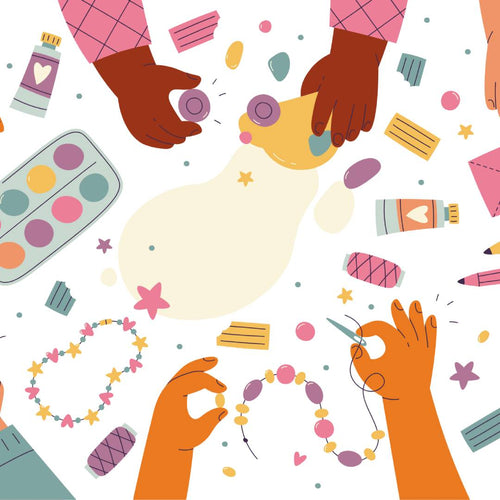It’s exciting once our little ones are finally big enough to start taking part in craft time, but trying to decide what exactly to do can be a challenge at times, even when we’re not dealing with decision fatigue. Fortunately, we’re here today to throw a few ideas into the ring to get you started. You can even tailor each of these to suit your child’s abilities as they grow and their fine muscle control and hand-eye coordination begin to improve!
Finger Painting
This is one that many kids love. And that’s because it’s incredibly fun and easy for them, though on a parental/caregiver level, it may take a bit of preparation. First, you’ll need to make sure you’ve got some good quality, non-toxic paints – have a look at your local stores, and you should be able to find some specifically designed for finger painting. Next, you’ll need an appropriate surface. Any paper will do – you don’t need to go out and buy canvases (unless that’s what you want, in which case, go for it!). Finally, it’s usually a good idea to find somewhere that’s either easy to clean, or isn’t such a big deal if paint does get spilt – because it absolutely will, especially with the younger ones. Aside from that, it’s a great way for them to learn about colours, how they mix, and to make a start on their artistic skills.
Sponge or Drip Painting
This is, of course, very similar to finger painting, but it allows them to manipulate tools – in this case, either a sponge or a dropper of some sort. For the sponges, you can grab some from your local shop and cut them up into fun shapes, then let the kids dip them into paint to stamp onto paper – easy! Drip painting can be a little more abstract. Fill a few dropper bottles with their chosen paint colours, then drip the paint down – this can be done with slow drips or, if you want more solid lines, squeezing your bottle a bit harder. This is one activity where having some leftover Haakaa Silicone Colostrum Collectors can be useful, as they avoid waste but are perfect for carefully dripping pretty much anything you want out of them!
Homemade Musical Instruments
When it comes to homemade instruments, the options are almost limitless – it really comes down to what you choose to class as one. Percussion instruments are probably the easiest and require little more than the traditional pot and wooden spoon, but you can build up from there with very little trouble indeed. Your old Gen. 3 bottle you don’t need anymore? For older children, simply fill it up with dry beans, make sure the lid is very tightly attached, and you’ve got a DIY shaker! Boost the security of the lid by taping it down and decorating it with stickers or other fun options to really make a go of it – though, as always, keep a very close eye on any little ones who are using these, as stray beans can pose a choking hazard.
If you really want to get crafty, you could also try making panpipes! And it’s easier than you’d think. For the pipes, get some paper straws and an ice block stick. Cut the straws to the length you would like, stepping down in even increments, then glue them to the stick (keeping the tops in line with one another). You can decorate the stick with things like ribbon or washi tape, or just colour it with kids’ paint or markers. Once it’s all dry, blow across the top of the straws and enjoy the sounds you get from them – you can even create a few different ones with various lengths and see what difference it makes.
Nature and Collages
Technically two different activities, they go so well together we’ve decided to list them as one. To start with, a nature walk – even if it’s just in your own backyard – can be a great way to spend a morning or afternoon. Collect leaves, petals, flowers, or even some interesting sticks and pebbles. See how many you can each identify, and take some home with you. Once you’re home, it’s time to get started! Get some craft card (or even just normal paper), some glue, and get collage making. You can add anything you’d like, from the leaves you’ve collected to smaller decorations you’ve got in your collection at home, such as stickers, mini pompoms, or even pipe cleaners. You can even take your collected treasures and use them on paper plates or make some egg carton caterpillars!
Origami
This one is great for developing fine motor skills, though it might pay to wait until they’re a tiny bit older to avoid the frustration that can come with folding fiddly little pieces of paper. Luckily, there is a vast range of experience levels when it comes to origami – everything from sturdy paper planes, hats and envelopes to intricate plants, animals and other shapes. Starting off with those simpler shapes then gradually building up to the more complex ones is a great way to track progress and get the little ones feeling a sense of accomplishment once they master a new design. Plus, in addition to the fine motor skill development this will give them, you can use origami as a fun way to teach colours and shapes at the beginning stages!
There are so many things that involve arts and crafts that we can do with our little ones, from all ages. This is merely scratching the surface of what’s out there – there are also things like playdough (and there are so many children’s tools designed specifically for playdough), colouring, and more. And if there’s one thing we know, it’s that engaging in art activities has a huge range of fantastic benefits for children, from physical development to fostering creativity.

